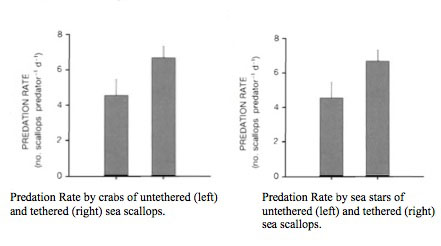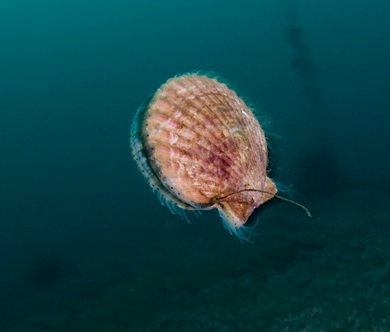Bivalve Behaviors
Biology 342: Animal Behavior
Fall 2012
Melissa Ashbaugh, Robin Byron, & Wyatt Gormley
| Home | Escape Behavior | Reproduction and Development | Feeding Behaviors | References | Course Home |
Escape Behavior in Scallops
Bivalves are a diverse class which perform diverse escape behaviors. Sea scallops in particular perform a fascinating antipredation behavior, as shown in the video below. When threatened, scallops will swim away from potential predators by clapping the valves of their shell together, propelling themselves forward and away from predators. After several claps the scallop sinks to the ocean floor.
Survival Value
Scallop swimming, as an antipredation strategy, is of clear survival value. Animals such as crabs and starfish prey upon scallops and scallops' swimming allows them to escape such attacks.
Experiments have been performed comparing predation by crabs and sea stars on unrestrained sea scallops and sea scallops tethered in place so as to be incapable of active escape (Barbeau and Scheibling, 1994). In this experiment, tethered sea scallops experienced an increased predation rate from both crabs and sea stars than their untethered brethren. The increase in predation was significantly greater in sea stars. This is likely because, although active escape is beneficial against both predators, an encounter between a crab and a scallop is much more likely to result in the scallop being eaten, regardless of any behavioral response the scallop may have, whereas active escape behavior significantly affects the predatory success of a sea star or other slow-moving predator.
In this way, swimming helps sea scallops escape predators, especially when those predators are slow moving.

Mechanism
The type of swimming scallops use during escape behavior, called burst swimming, is a stereotyped escape response(Legault and Himmelman, 1993). Burst swimming utilizes the phasic muscle, a component of the adductor muscle. The muscle contracts when arginine phosphate and glycolytic ATP production cause acidification of the intracellular environment in an anaerobic process. The scallop then recuperates through aerobic ATP production in the mitochondria (Guderley et al., 1995).
The adductor muscle rapidly closes the valve, propelling the scallop backward (Olson and March 1993). The shell then opens as a response of the hinge ligament.

Ontogeny
Although scallops of different ages demonstrate similar responses to threats, there are behavior differences between older and younger scallops. The specific mechanism for how behavioral differences arise as the animal ages requires further study.
Scallops of different ages have different swimming techniques, although different techniques are similarly effective (Schmitt et al, 2008). Older scallops have less energetic capacity, both aerobic and anearobic. This is combated by the ability of older scallops to stabilize changes in redox potential, pH and loss of glutathione in the swimming adductor muscle (Philip, Eva E. R., et al.). These changes match changes in habitat use (Arsenault and Himmelman, 1996).
Smaller, and therefore younger, scallops remain mostly hidden under shells and rocks while larger scallops tend to be in the open and exposed. Bigger scallops are less vulnerable to predators like crabs and starfish and so have less need to stay hidden (Frechette et al., 2006).
Phylogeny
There is large phenotypic variability in escape behavior. As swimming is the primary escape mechanism in scallops, variation in this behavior has been found. Scientists have found variation in each of the following measures of threat response:
- time to respond
- the number of claps made in response to continuous stimulation
- duration of response
- response intensity, measured by the rate of clapping
- proportion of initial escape capacity recoverable within a given recuperation period.
Variation in swimming behavior has been shown to be heritable. In addition, studies have found that many response traits are correlated and have coevolved so that they are passed together.